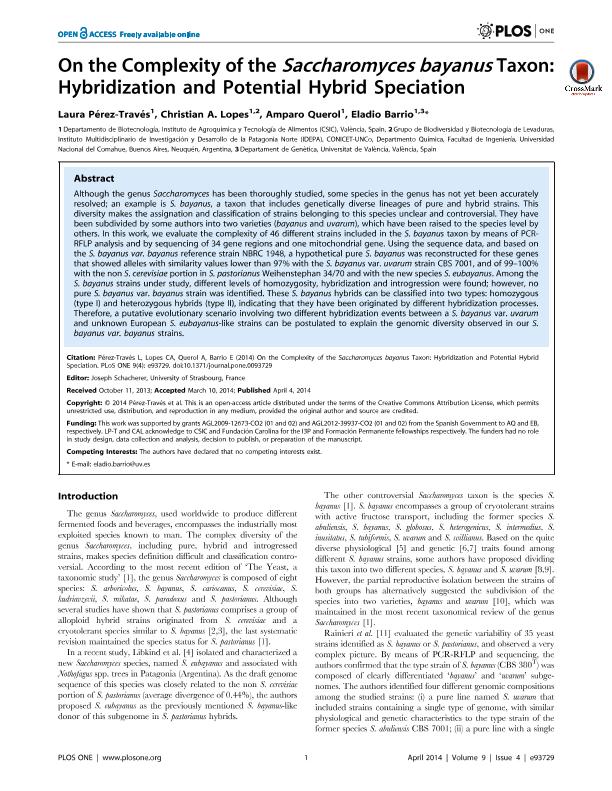Mostrar el registro sencillo del ítem
dc.contributor.author
Pérez Través, Laura
dc.contributor.author
Lopes, Christian Ariel

dc.contributor.author
Barrio, Eladio
dc.contributor.author
Querol, Amparo
dc.date.available
2017-01-19T20:28:24Z
dc.date.issued
2014-04
dc.identifier.citation
Pérez Través, Laura; Lopes, Christian Ariel; Barrio, Eladio; Querol, Amparo; On the Complexity of the Saccharomyces bayanus Taxon: Hybridization and Potential Hybrid Speciation; Public Library of Science; Plos One; 9; 4; 4-2014; 1-14
dc.identifier.issn
1932-6203
dc.identifier.uri
http://hdl.handle.net/11336/11661
dc.description.abstract
Although the genus Saccharomyces has been thoroughly studied, some species in the genus has not yet been accurately resolved; an example is S. bayanus, a taxon that includes genetically diverse lineages of pure and hybrid strains. This diversity makes the assignation and classification of strains belonging to this species unclear and controversial. They have been subdivided by some authors into two varieties (bayanus and uvarum), which have been raised to the species level by others. In this work, we evaluate the complexity of 46 different strains included in the S. bayanus taxon by means of PCR-RFLP analysis and by sequencing of 34 gene regions and one mitochondrial gene. Using the sequence data, and based on the S. bayanus var. bayanus reference strain NBRC 1948, a hypothetical pure S. bayanus was reconstructed for these genes that showed alleles with similarity values lower than 97% with the S. bayanus var. uvarum strain CBS 7001, and of 99–100% with the non S. cerevisiae portion in S. pastorianus Weihenstephan 34/70 and with the new species S. eubayanus. Among the S. bayanus strains under study, different levels of homozygosity, hybridization and introgression were found; however, no pure S. bayanus var. bayanus strain was identified. These S. bayanus hybrids can be classified into two types: homozygous (type I) and heterozygous hybrids (type II), indicating that they have been originated by different hybridization processes. Therefore, a putative evolutionary scenario involving two different hybridization events between a S. bayanus var. uvarum and unknown European S. eubayanus-like strains can be postulated to explain the genomic diversity observed in our S. bayanus var. bayanus strains.
dc.format
application/pdf
dc.language.iso
eng
dc.publisher
Public Library of Science

dc.rights
info:eu-repo/semantics/openAccess
dc.rights.uri
https://creativecommons.org/licenses/by/2.5/ar/
dc.subject
Saccharomyces Eubayanus
dc.subject
Saccharomyces Pastorianus
dc.subject
Yeast
dc.subject
Diversity
dc.subject.classification
Genética y Herencia

dc.subject.classification
Ciencias Biológicas

dc.subject.classification
CIENCIAS NATURALES Y EXACTAS

dc.title
On the Complexity of the Saccharomyces bayanus Taxon: Hybridization and Potential Hybrid Speciation
dc.type
info:eu-repo/semantics/article
dc.type
info:ar-repo/semantics/artículo
dc.type
info:eu-repo/semantics/publishedVersion
dc.date.updated
2017-01-17T19:10:19Z
dc.journal.volume
9
dc.journal.number
4
dc.journal.pagination
1-14
dc.journal.pais
Estados Unidos

dc.journal.ciudad
San Francisco
dc.description.fil
Fil: Pérez Través, Laura. Consejo Superior de Investigaciones Cientificas. Instituto de Agroquimica y Tecnologia de Alimentos; España
dc.description.fil
Fil: Lopes, Christian Ariel. Consejo Nacional de Investigaciones Científicas y Técnicas. Centro Científico Tecnológico Patagonia Norte. Instituto de Investigación y Desarrollo En Ingeniería de Procesos, Biotecnología y Energías Alternativas; Argentina. Universidad Nacional del Comahue. Facultad de Ingenieria. Departamento de Quimica; Argentina. Consejo Superior de Investigaciones Cientificas. Instituto de Agroquimica y Tecnologia de Alimentos; España
dc.description.fil
Fil: Barrio, Eladio. Consejo Superior de Investigaciones Cientificas. Instituto de Agroquimica y Tecnologia de Alimentos; España
dc.description.fil
Fil: Querol, Amparo. Consejo Superior de Investigaciones Cientificas. Instituto de Agroquimica y Tecnologia de Alimentos; España. Universidad de Valencia; España
dc.journal.title
Plos One

dc.relation.alternativeid
info:eu-repo/semantics/altIdentifier/url/http://journals.plos.org/plosone/article?id=10.1371/journal.pone.0093729
dc.relation.alternativeid
info:eu-repo/semantics/altIdentifier/doi/http://dx.doi.org/10.1371/journal.pone.0093729
Archivos asociados
